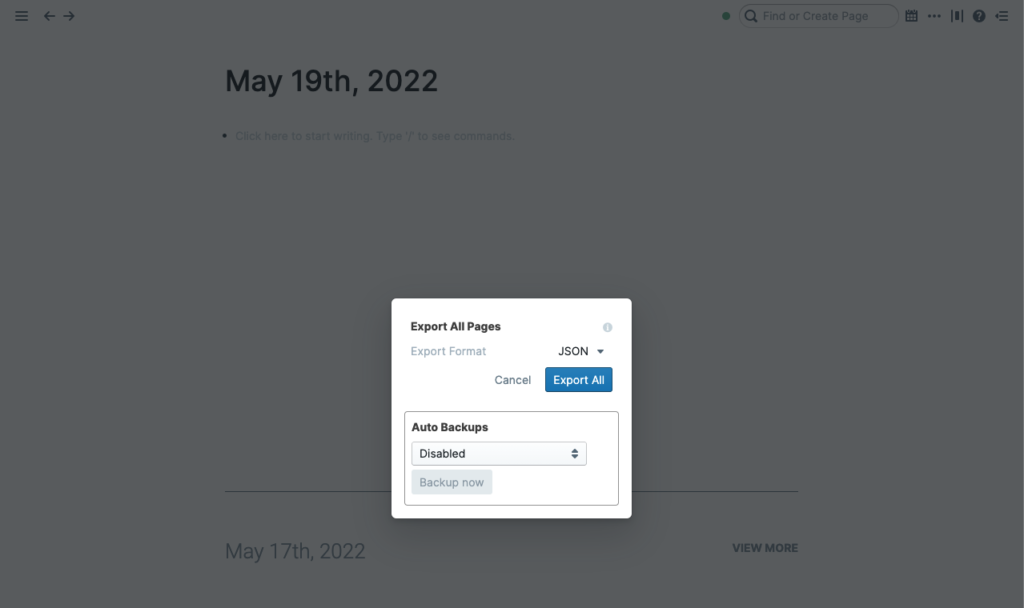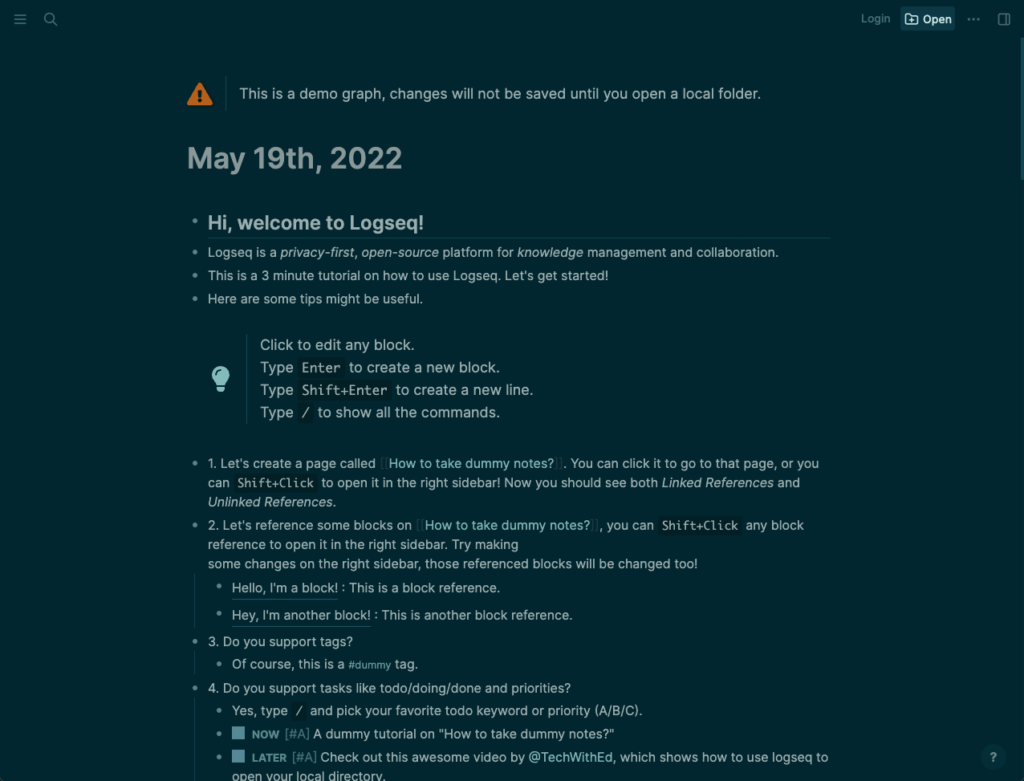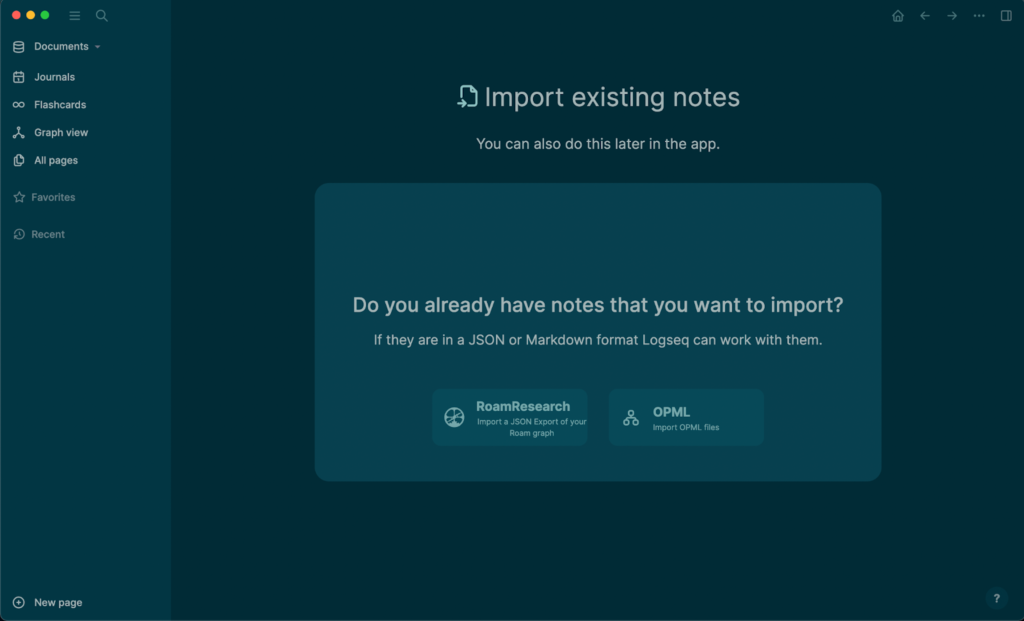Ever since Roam popularised networked thinking, a few alternatives have become available. Logseq is local-first, plain text, and a block-based outliner app similar to Roam Research. While Roam partly inspires it, Logseq is not just a Roam clone and has features that make it a unique tool for thought. If you are considering switching from Roam to Logseq, read on to explore key considerations and steps to ensure the transition goes smoothly.
Why you may want to switch from Roam to Logseq
While they may seem similar, Roam and Logseq have fundamental differences that may convince you to make the switch.
Open Source
Unlike Roam, Logseq is open-source software. There is no guarantee that the software companies you depend on these days will not go out of business. With open-source software, you have peace of mind that you can still access your notes, even if the Logseq team calls quit tomorrow. Your notes will outlive these companies.
Built-in features
Logseq offers a few built-in features that make it stand out from Roam, such as:
- Built-in spaced repetition system. By adding #card to a block, you can turn it into a flashcard. You can also type in “/cloze” if you want to make cloze deletion flashcards. Reviewing your flashcards is as simple as clicking on Flashcards in the left sidebar.
- Advanced task management. While Roam can handle task management by creating to-do lists and ticking them off, it is not as advanced as Logseq’s. Logseq adds to Roam’s task management features by allowing you to differentiate between the task states, prioritise your tasks, add deadlines and schedules, and track how long it took for you to complete the task. You can read more about task management in Logseq here.
- Built-in PDF highlighter. By dropping a PDF file in your notes, you can open them in Logseq and highlight texts. These highlights can be used as block references, making Logseq suitable for researchers reading PDF journals. Researchers may also appreciate that Logseq can link directly to their PDFs with the Zotero integration.
While these workflows can be done in Roam, these features are built-in in Logseq and do not require you to use other workarounds or plugins.
Plain-text notes
If accessing your notes with other apps is crucial, you may consider switching to Logseq, a plain-text based app. While most plain-text based apps do not support the block structure implemented in Roam, Logseq does, which means you can access your notes both with Logseq and with other apps that can read plain-text. Instead of relying on proprietary formats, Logseq can ensure the durability of your ideas.
Security
Because your notes are located on your computer, there is no worry about the security of your notes. Only you have access to your notes. Though with Logseq you lose out on the sync feature of hosted options, you can still keep your files in a cloud service provider like Google Drive or Dropbox and sync your notes across your devices securely.
Why you may want to stick with Roam
As you have seen, there are some fundamental differences between Logseq and Roam. However, if these features are not relevant to your core concerns, you may not necessarily want to switch. You may consider sticking to Roam if the following features are essential to your workflow:
- Collaborative knowledge management. Because your graph is hosted in Roam servers, you can share your notes with others for collaboration. Logseq uses local files and is not collaboration friendly, with it being more suitable for building your digital garden.
- Syncing between apps. If you want to access your Logseq graph on other devices, you may need to use cloud services to set up your sync configuration. Because Roam hosts your notes for you, you can access your notes with multiple devices without any tinkering.
- Kanban boards, Pomodoro timers, and tables. If features such as Kanban boards, Pomodoro timers and tables are essential to your workflow, you may consider sticking with Roam instead of migrating to Logseq. These features do not transfer nicely to Logseq, and if your notes rely heavily on them, it might not be worth it to migrate.
As usual, you should not switch if you do not need to. While the shiny toy syndrome might tempt you to switch your tools for thought, switching apps can cost you time and energy that could be spent refining your craft.
How to migrate from Roam to Logseq in three steps
If you have decided you want to switch from Roam to Logseq, there are only three simple steps you can go through to migrate.
1. Export your files from Roam
Open your Roam database and click on the three dots in the top right corner. Then, select the “Export All” option, set the export format to JSON, and export all your notes. Roam will download your database into a zipped folder, which you need to unzip. At this point, you should have a JSON file that is ready to be imported into Logseq.

2. Set up Logseq
Next, launch Logseq. You can either download the desktop app or use the web version of Logseq by opening a local folder. If you want to use the web app, open a local folder by clicking on the open button at the top right corner. You can then create a new folder or open an existing folder. This is where Logseq will store all your Markdown files. Just follow the same process if you download the desktop app.

3. Import your notes into Logseq
Once Logseq launches, click the three dots in the top right corner and select `Import”. There will be an option to import a JSON export of your Roam graph. This process might take some time, depending on the size of your Roam graph.

Getting used to Logseq
Great job, you are now all set up with Logseq! If you have previously used Roam, you might feel at home with Logseq. Some features such as alt/option-drag to make a block reference and using page and block backlinks and the sidebar are implemented the same way. However, there are some little differences you need to know about when making the switch so you can used to them.
- Daily Notes page vs Journal. In Roam, you are greeted by the Daily Notes page as you open the app. Logseq, however, calls this Journals. They both work the same way, act as a frictionless way for note-taking, and can be accessed via the left sidebar.
- Case sensitive links. In Roam, “Productivity” and “productivity” are two different pages. In Logseq, “Productivity” and “productivity” are considered one and the same page.
- Query syntax. Queries are done differently in Logseq, with it using a different syntax. You can learn more about it here.
- Aliases. Unlike Roam, you can use aliases to link to a page with a different word. For example, by writing down “alias:: latte” on the first block of the page [[coffee]]. You can search for [[latte]] or click on [[latte]] to bring you to the page [[coffee]]. You can also add multiple aliases by separating them with a comma, such as “alias:: latte, americano, espresso, mocha”.
- Readwise integration. Unlike Roam, Logseq does not have a way to integrate automatically with Readwise yet. If you want to connect Readwise to Logseq, you can do so via Obsidian. Launch Obsidian and pick the same vault you used for Logseq. With the official Readwise Obsidian plugin, it will create pages for your Readwise notes in Obsidian, which also shows up in Logseq as they both share the same folder.
- Linking unlinked references. In Roam and Logseq, you can check unlinked references to a page at the bottom of the page. This allows you to connect your notes in meaningful and surprising ways and helps you to generate new ideas and thoughts. However, unlike in Roam, where linking your unlinked references is as easy as clicking the link button, you need to manually select the term and type in double brackets to link it.
Whether you decide to migrate from Roam to Logseq or stick with using Roam, it is not the tool you use but how you use it to shape your thinking. If you would like to learn more about using Logseq, join our community’s digital gardening support group.
